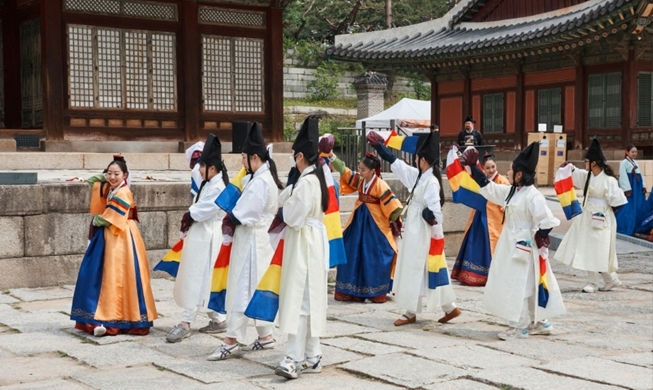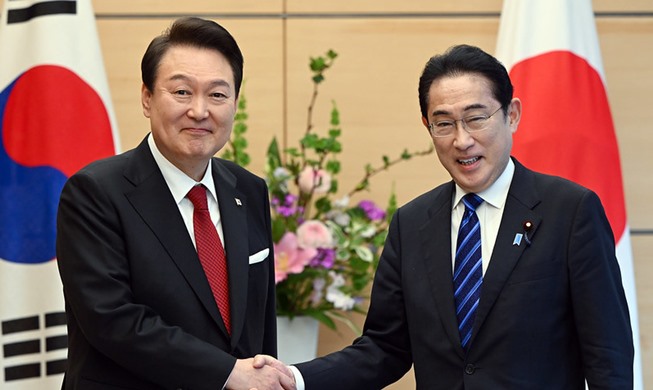-
 Korea.net's 24-hour YouTube channel
Korea.net's 24-hour YouTube channel- NEWS FOCUS
- ABOUT KOREA
- EVENTS
- RESOURCES
- GOVERNMENT
- ABOUT US
This is a follow-up article to a series of interviews with the contestants in the 2015 “Exploring Korean Humanities Together” competition held in Jecheon, Chungcheongbuk-do Province, on July 4.
Khalilzade Nihat, Azerbaijan, Hanyang University
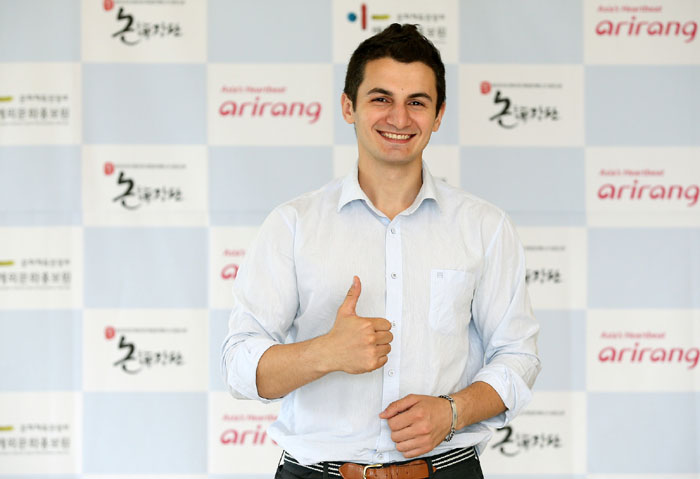
- In the competition, your team focused on art collector Chun Hyeong-pil (1906-1962) (전형필, 全鎣弼), who went by the pen name of Kansong (간송, 澗松). How did you hear about him? What’s your take on what he did?
What Chun did is something that ordinary people just wouldn’t do. For example, if I have KRW 100,000 in hand, would I be willing to spend KRW 90,000 of it to purchase historical relics, as he did? I wouldn't. While working on our presentation about the art collector, I volunteered at the Kansong Museum. There, I met the other people working at the museum, talked with them and learned much more about him. I realized that he did a super job at preserving ancient Korean art. Taking this opportunity to be part of the competition, I’d like to help more people learn about who he was and what he did. Thanks to his acts, which were regarded as crazy back then, nowadays people can enjoy a wide range of valuable historical artifacts, cultural assets that might otherwise have been lost. He was not simply an art collector, but a person who would buy up famous works of art for the people. If he were just a collector who liked to hoard his treasures, he would have looked for things not only in, but also out, of Korea. He invested almost all of his wealth into the purchase of Korean historical works of art. It’s amazing.
- What kinds of lessons do you learn from him and his deeds?
Without him, the Korean people would now not have access to many of the nation’s cultural properties. Many historical works of art in Azerbaijan were destroyed and plundered by the Soviet Union. If there were a Kansong in my country at that time, many more relics would now exist, reaching the modern Azerbaijani people, I believe.
I believe that these days we will never see an individual who is willing to spend all his or her money on a single cause. While preparing for this competition, I was surprised to learn that many people don’t know about him. Kansong must be remembered and thanked by not only non-Koreans, but also by the Korean people themselves. I’ve learned a lot from his story. Many people, too, must hear about him.
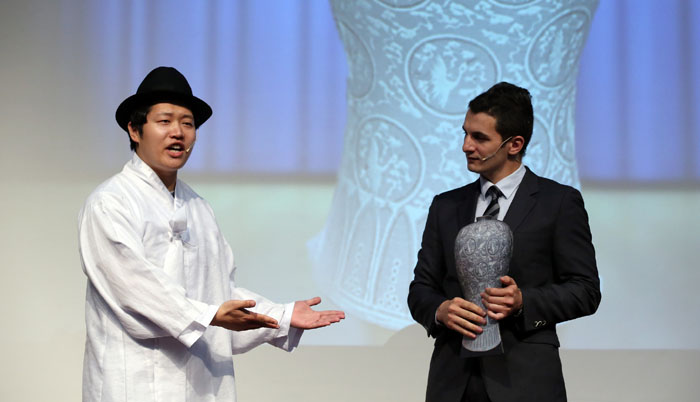
Khalilzade Nihat (right) gives a presentation that sheds light on art collector Chun Hyeong-pil (1906-1962) during the 2015 ‘Exploring Korean Humanities Together’ competition held in Jecheon, Chungcheongbuk-do Province, on July 4.
- Tell us about how you first came to Korea.
It’s been almost five years since I first came here. Getting good grades in English helped me get admitted to Hanyang University on a scholarship. I am majoring in computer engineering. Korea has a lot in common with my home country, both linguistically and culturally. I felt familiar with this East Asian country from the beginning. It was not that difficult for me to learn Korean, as the language is similar to my mother tongue in terms of grammar. Before I came to Seoul, I took classes at a language school run by Keimyung University. I will be graduating next year. I am soon opening a restaurant in Sinchon, in western Seoul, a restaurant that will specialize in traditional Azerbaijani cuisine. I open this restaurant with the goal of giving more people a rare chance to taste traditional food from my country. I hope to settle down in this nation.
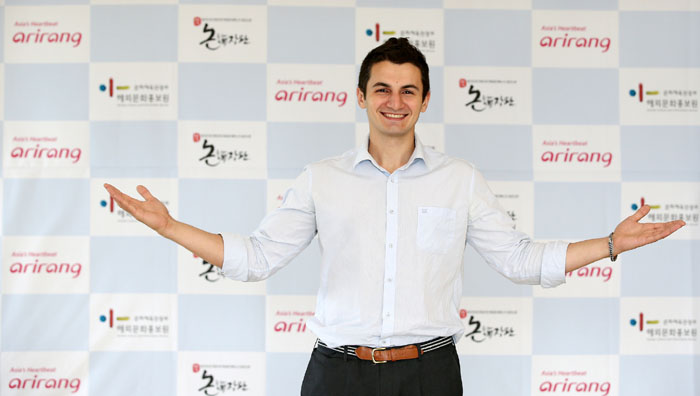
- Tell us about what you think about Korean society, its traditions and its people.
I really love this country as it hosts numerous programs for non-Korean residents, like the “Exploring Korean Humanities Together” competition. There is usually one or two events being held in my country, but Korea approaches non-Koreans like me with a variety of such programs, allowing us to have a hands-on experience of Korea's traditions and art. What I see firsthand here is quite different from what I imagined before I flew in. When many people in Azerbaijan think of Korea, the image of North Korea comes to mind. The first time I announced that I would be going to Korea to study, my parents tried hard to stop me. Having lived here for five years now, I know that Korea is the safest and the best country in which to live. The country has one-of-a-kind traditions, such as taking a sauna together, and has convenient transportation, too. The Internet here is the fastest in the world, too. I feel much more comfortable living here than in my country.
James Saitoti, Kenya, Chung-Ang University
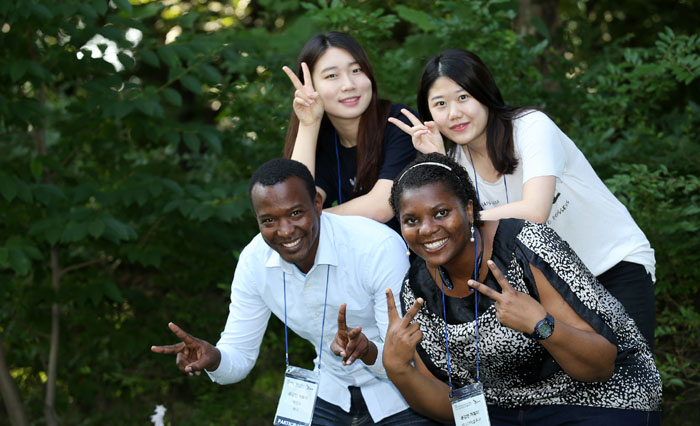
James Saitoti (front, left) works with Esther Abumchukwu from Nigeria, Seong Ji-hye (top, left) and Lee Yeon-ji, both Korean students at Sangji University, on a group project for the 2015 ‘Exploring Korean Humanities Together’ competition held on July 4 in Jecheon, Chungcheongbuk-do Province (North Chungcheong Province).
- Why did you decide to participate in the competition?
One of my friends told me about the event and persuaded me to join him on the project. I found it interesting and decided to give it a try.
- Please tell us about what made you come to Korea.
It has been four and a half years since I came here. Before that, I had no idea what kind of country Korea was. I didn’t speak a word of Korean, either. As soon as I arrived, I started courses at a language school and I have since tried hard to improve my Korean.
- How did you get first learn about Admiral Yi Sun-sin (1545-1598)?
Before I started this project, I knew nothing about who he was or what he had done. I took courses in Korean history when I was in my first year of university. During those classes, I got some general knowledge about Korean history, like the periods of Unified Silla (668-935), Goryeo (918-1392) and Joseon (1392-1910). I didn’t hear about Yi Sun-sin, though. Working on the project, I’ve learned a lot about the life of this historic figure and the legacy he left behind. I realize now what great deeds he did.
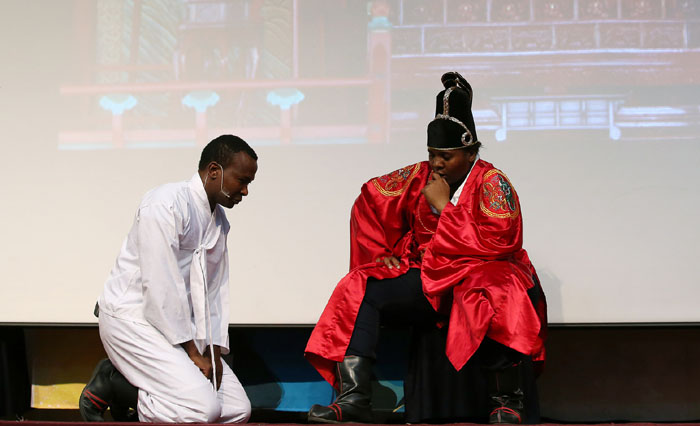
James Saitoti (left) plays Admiral Yi Sun-sin during the 2015 ‘Exploring Korean Humanities Together’ competition in Jecheon, Chungcheongbuk-do Province, on July 4. The Kenyan student gives a presentation that he worked on together with Esther Abumchukwu (right), a Nigerian student at Chonbuk National University, and two other Sangji University students.
- What have you learned from your experiences in the competition this time?
All I could think about when I started this project was, “I will do my best to make it successful.” I didn't think about how difficult it might be or how little I may know about the historical figure. I just worked hard with my friends. I tried to get my hands on anything related to Yi, from movies to documents. The more I learned about him, the more I was surprised to learn how great he was. Personally, I had time to look back on myself, too. “What could I do for my country?” I thought to myself many times. I’m greatly moved by his legacy. I wonder, “Would there be someone in the next one hundred years like Admiral Yi Sun-sin?”
By Sohn JiAe
Photos: Jeon Han
Korea.net Staff Writers
jiae5853@korea.kr
Most popular
- China warmly welcomes first Korea-born giant panda Fu Bao
- First hearing-impaired K-pop act hopes for 'barrier-free world'
- Novelist Hwang's 'Mater 2-10' shortlisted for Int'l Booker Prize
- Expats could account for 7% of population in 20 years: report
- Nat'l Fire Agency picks 137 elite staff for deployment abroad








